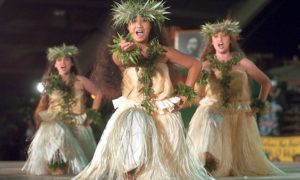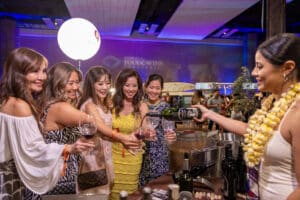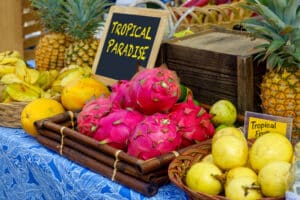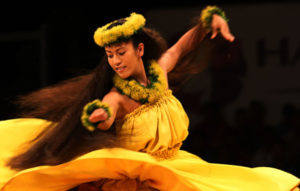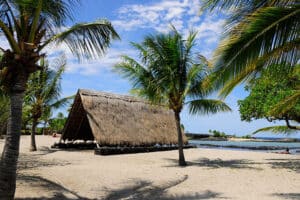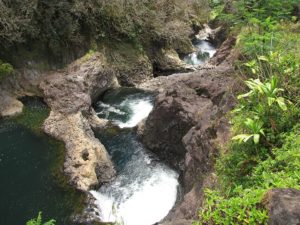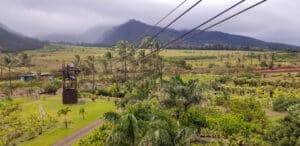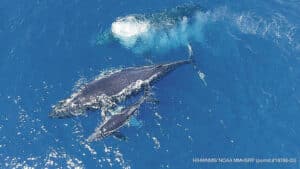Just 10 minutes north of Hilo, you’ll find an unexpected refuge. It hums with the gentle sound of slow, contented chewing. Here, under a canopy of shade, you might find yourself leaning back into a warm, steady body, feeling a heavy neck drape over your shoulder. That’s not a compression blanket. It’s a cow—hugging you back. Welcom to Krishna Cow Sanctuary, where cow cuddling is always the activity of the day.
The sanctuary is open seven days a week, 365 days a year from 11 a.m. to 2 p.m. The sanctuary offers an experience that’s as simple as it is unforgettable. You just show up—no tickets, no fuss—and for $20, you can spend an hour or three scratching velvety foreheads and stroking soft ears. And maybe, if you’re lucky, being enveloped in a warm bovine embrace.

Krishna Cow Sanctuary photo by @kayaslopez.
“They’re essential mothers,” says Narayan, the sanctuary’s founder. “If you lean into them, a lot of them will wrap their neck around you. It’s pure love. People cry.”
How 250 Cows Found a Forever Home
The sanctuary’s story starts with a crisis. Years ago, a major dairy operation on the Big Island was forced to shut down due to environmental issues. The cows—dozens of them—were slated for slaughter.
Narayan, a lifelong vegetarian with a deep passion for organic farming, couldn’t let that happen. “You can’t have food sovereignty without cow poop,” he says. “Cows are essential to the ecosystem.” He began raising money, determined to save the herd. Against the odds, he succeeded—launching the sanctuary and giving the animals a second chance at life.
But after the initial wave of donations faded, Narayan had to find other ways to keep the sanctuary going. That’s when Cow Cuddling was born. It’s not just as a novelty for visitors, but as a way for people to connect with the animals, learn their importance, and help sustain the sanctuary financially.
Today, the sanctuary is home to 250 bovines, spread across an ever-growing area of lush grazing sites borrowed from local farm owners who understand the benefits of bovines on the land.
More Than Just Cute Faces: Why Cows Matter
Cows often get a bad reputation for their role in climate change. But Narayan is quick to explain the difference between industrial livestock farming and free grazing, which is what happens at his sanctuary.
In large-scale, confined feeding operations—where animals are crowded together, fed grain instead of grass, and waste builds up in massive lagoons—methane emissions are concentrated and harmful.
But cows on pasture are different. When they graze naturally, they’re part of a balanced carbon cycle:
- Methane: Yes, cows release methane when they digest food. But, in natural grazing systems, this methane is part of a short-term cycle. Plants absorb carbon dioxide, cows eat the plants, release methane, and after about 10 years, that methane breaks down into CO₂, which plants absorb again.
- Carbon Sequestration: Even better, healthy grazing can pull more carbon into the soil than it releases. As cows eat grass, the plants respond by growing deeper roots, depositing carbon into the soil. Over time, this builds richer soil, increases biodiversity, and helps the land store more carbon.
- Beneficial Fungi: As cows graze and fertilize naturally, they also help create the perfect conditions for beneficial fungi to thrive in the soil. These fungi form underground networks that help plants absorb nutrients and water more efficiently, improve soil structure, and lock away even more carbon. It’s a quiet, invisible partnership that keeps the whole ecosystem healthier.
“When you do it right, cows are actually great for the environment,” Narayan says. “They fertilize the land, increase biomass, and help the soil lock away carbon. That’s the opposite of what most people think.”
Giving Back to the Big Island
When people experience the sanctuary and speak with Narayan and the staff, they realize quickly that the mission is far bigger than animal rescue. It’s about creating a ripple effect of benefits across the island:
- For visitors: A new experience – – cow cuddling. A deeply calming, joyful experience that connects people to animals and the land in a way that’s grounding and healing.
- For landowners: Through the Bovine Land Management program, cows help maintain pastures, reduce invasive plants, and improve soil health naturally.
- For the environment: Every acre of healthy pasture managed by grazing cows captures more carbon, supports pollinators, and increases local food resilience.
And perhaps most importantly, the sanctuary challenges the narrative about cows—showing that when they live naturally, they’re partners in ecological health.
Planning Your Visit to Krishna Cow Sanctuary
Visiting Krishna Cow Sanctuary is easy. You don’t need to book in advance—just drive 10 minutes north of Hilo, show up between 11 and 2, and bring $20 per guest for cow cuddling. You’ll be welcomed into a shady, open-air space where the friendly cows lounge on wood shavings, enjoying the island breeze. They love scratches and cuddling. You might not know it but when a thousand-pound animal rests her head on your shoulder, you’ll feel a sense of peace that’s hard to put into words.
How to Support the Sanctuary—Even from Afar
If a trip to Hilo isn’t on your calendar just yet, you can still be part of the sanctuary’s mission. Donations and cow sponsorships help feed and care for the animals year-round, and support the land management work that benefits the entire island.
Put Hilo on Your Bucket List
Whether you’re a lifelong animal lover looking for cow cuddling, a traveler looking for a unique experience, or someone who just needs a break from the noise of the world, Krishna Cow Sanctuary is the kind of place that stays with you. It’s a reminder that harmony with nature is possible—and that sometimes, the best therapy comes with four legs, a swishing tail, and a warm hug.
Visit. Donate. Sponsor a cow. However you choose to get involved, you’ll be helping keep this island treasure thriving—one cuddle at a time.
